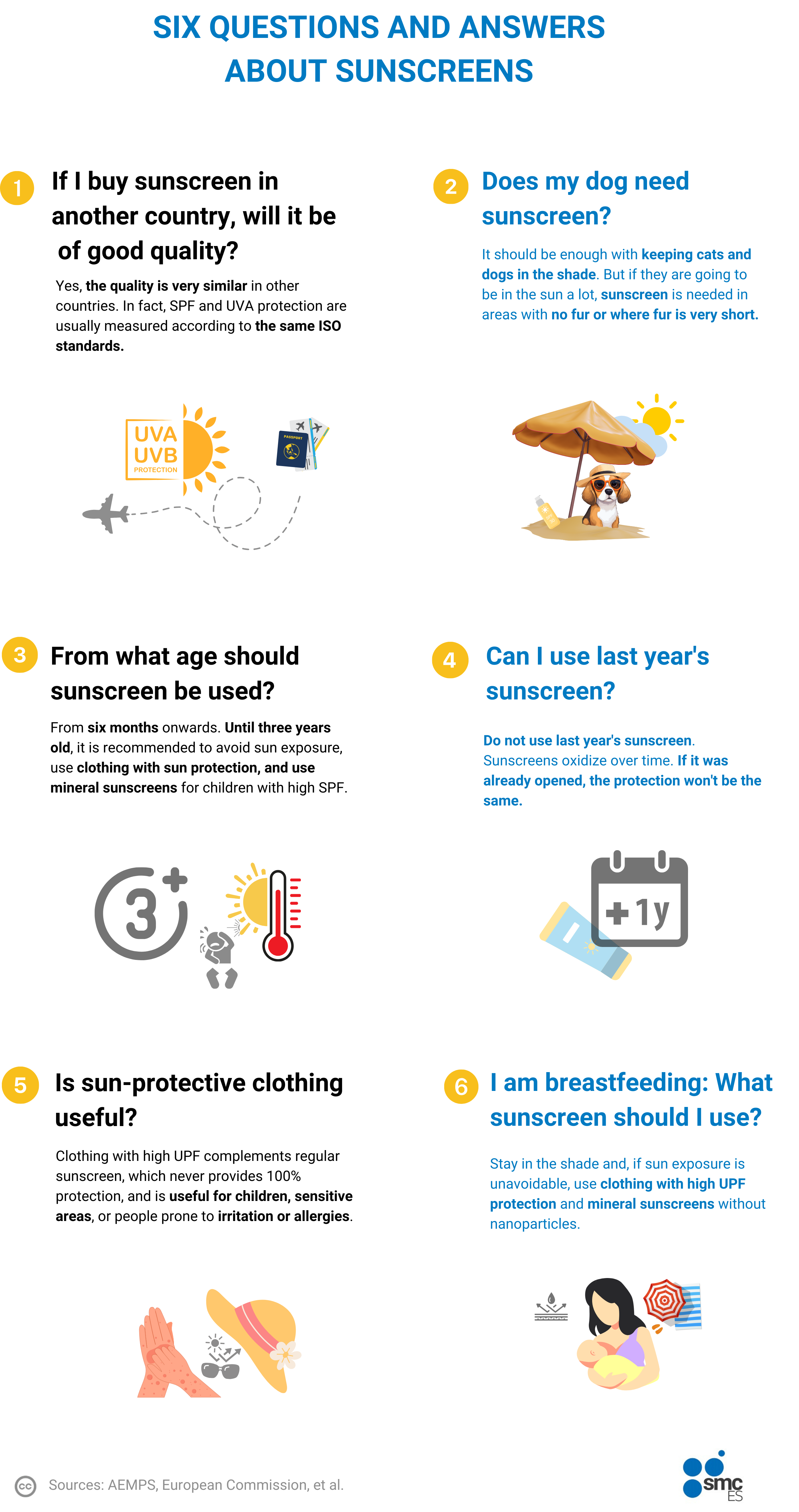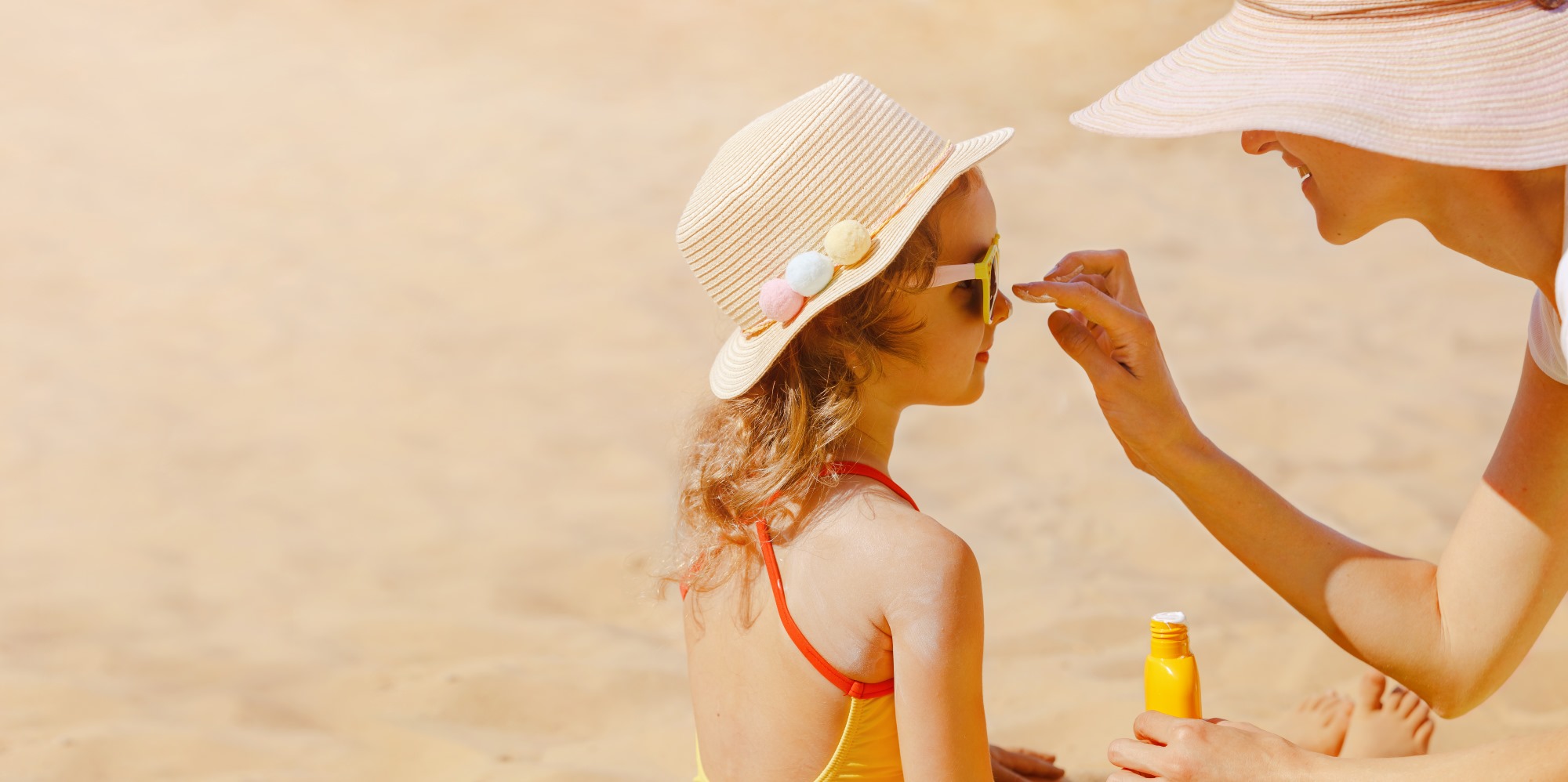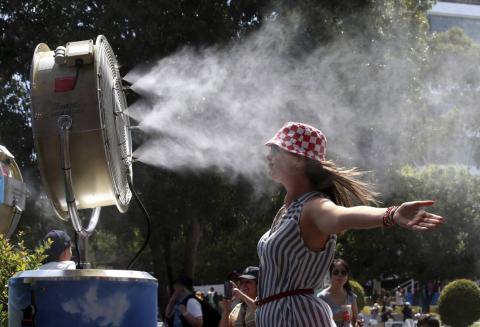Can you use last year’s sunscreen?
If the container is open, last year’s sunscreen shouldn’t be used. Over time, sunscreens oxidize and lose their effectiveness. The Spanish Agency for Medicines and Health Products (AEMPS) and the European Commission estimate that, after a year, once the container is opened, the protection may not be adequate and therefore advise against its use after that date.
How often should it be applied?
The AEMPS recommends applying sunscreen every two hours and after swimming, drying off, or sweating. “This is the time it takes for the product to degrade on the skin,” explains Eduardo Noguera, Clinical Head of the Dermatology Department at the Valencian Institute of Oncology, to SMC Spain. “This time is shortened if there has been prolonged bathing or exercise,” he adds.
For daily activities, such as buying bread, going to the office, or sitting on a terrace in the shade, José Aguilera Arjona, a biologist specialized in Photobiology, and national coordinator of the Spanish Group of Photobiology of the Spanish Academy of Dermatology and Venereology (AEDV), explains to SMC Spain that it is enough to apply sunscreen once in the morning. However, for other activities such as exercising, swimming, or going to the beach, it should be applied every hour and a half or two hours.
Both experts agree that water-resistant sunscreens (waterproof) are more suitable for sports, sweating, or swimming, as they adhere better to the skin. Nonetheless, they still recommend reapplying every two hours.

How much is necessary?
The AEMPS recommends using two extended lines on the fingers to protect the face and two tablespoons for the body (about 30 ml), which is the amount used to analyze the quality of the product, and what other official guidelines indicate. "Users apply between three and four times less," notes Aguilera Arjona.
"If the applied protection is reduced by half," warns the European Commission in its sunscreen regulations, "the protection offered can be up to three times less."
Additionally, the AEMPS reminds that the entire body should be well-covered, especially sensitive and often forgotten areas, such as the lips, ears, or the bald spot in people with little hair, and recommends applying the product half an hour before sun exposure.
What does the sun protection factor (SPF) measure?
The sun protection factor (SPF) compares the time it takes for a person with sunscreen protection to burn versus the time it takes without it. For example, a person with SPF 30 protection would take 30 times longer to burn than someone without protection, and a person with SPF 50 would take 50 times longer. This is, if all other conditions being equal, as ultraviolet (UV) radiation depends on many factors and not all skin types tolerate it the same way.
However, this numbering can be misleading. SPF filters never provide 100% protection; in fact, as we have seen, SPF is not a percentage, but there are products with SPF 90+ or even 100 that might suggest otherwise. Additionally, UV protection does not follow a linear scale. A 50+ protection is practically the same as a 90+ or 100 and in no case guarantees total protection.
Moreover, SPF does not measure protection against UVA rays, a type of ultraviolet radiation. Skin burns, which SPF protects against, are usually caused by UVB radiation. But UVA rays are also dangerous. They contribute to premature skin aging and, like UVB rays, increase the risk of cancer and affect the immune system.
In Europe, UVA protection is often indicated by surrounding it with a circle. “This means that the sunscreen is broad-spectrum, meaning it also protects against the generation of skin pigmentation, at least one-third of the sun protection factor. Therefore, if the sun protection factor is 60, the UVA PF must be at least 20,” explains Aguilera Arjona.
To avoid confusion regarding protection against different types of ultraviolet radiation, the European Commission's regulations on sunscreens require the use of simple descriptors such as “low protection,” “medium protection,” “high protection,” or “very high protection” on all packaging. The AEMPS recommends combining products that protect against both UVB and UVA radiation with other protective measures such as clothing, hats, and sunglasses.
If I buy sunscreen in another country, will it be of good quality?
"The effectiveness of sunscreens at an international level is practically the same," explains Aguilera Arjona, although he notes that each country has its own regulations. "Europe has a recommendation, from 2006, on how labeling should be," he adds.
According to the expert, all these products follow the same ISO standards, which are international regulations that specify whether a sunscreen is broad-spectrum (UVB-UVA), water-resistant, or has a certain SPF. "A sunscreen that is 50 plus in the United States," he compares, "is the same in Australia, Japan, and Spain or Europe."
In recent years, the AEMPS has observed "some variability" in the application of these standards, which has led to various alerts. The most recent, from last March, was based on a study by the Organization of Consumers and Users (OCU) and the International Consumer Research and Testing (ICRT), which reported that half of the sunscreens analyzed did not meet the advertised protection, a claim that has been questioned by the industry and some associations. The AEMPS has taken action on each suspicion and is promoting changes in labeling and the way SPF is measured to prevent such issues in the future.
Are clothing and other items with UPF filter useful?
Before answering the question, it should be clarified that sunscreens use chemical filters that absorb ultraviolet rays. They can be combined with other substances and are available in many forms, from lip balms to gels or invisible sprays, which can be useful in specific areas and conditions such as seborrheic dermatitis, acne, or psoriasis. However, they can cause problems like allergies, toxicity, and irritation.
Physical filters, on the other hand, act as a physical barrier that reflects and disperses ultraviolet rays. These include everything from clothing or umbrellas to opaque patches. The protection factor of each item must be considered. It is measured in UPF units, and like the SPF of sunscreens, it compares the time it takes for a person to burn with a fabric and without it. The numbering is also the same (from 6 to 50+), but the protection depends on other factors:
- The color of the fabric: Dark dyes increase the level of protection of a fabric by three to five times. "The darker the color of the garment, the better it blocks radiation," explains Juan Jurado Moreno, doctor and head of the Dermatology Working Group of the Spanish Society of General and Family Doctors (SEMG), in an article.
- The type of material, texture, and thickness of the fabric: If the space between threads is very small and, therefore, if the weight and thickness of the fabric is high, the protection will be greater. This means that each material has a specific protection level. "Polyester or rayon fabrics protect more than cotton," Jurado compares. "Synthetic or semi-synthetic fabrics, or cotton, protect more than fabrics made with linen."
- Factory finish and degree of hydration: To increase UPF, fabrics can be treated with detergents that absorb ultraviolet radiation (such as titanium or zinc oxide). Additionally, "if a garment is wet," the dermatologist notes, "its protection level is reduced by half."
When choosing sunglasses, care must be taken: At a minimum, they should have a CE mark, specify the level of ultraviolet protection (UVB-UVA), and indicate the type of filter (polarized or photochromic) and its category, which ranges from 0 to 4 depending on the darkness of the lens. The AEMPS reminds that no filter, neither physical nor chemical, can protect 100%. Therefore, it urges combining different types of protection and avoiding prolonged sun exposure, especially during the central hours of the day.
Another type of sunscreen is the so-called mineral filters, which are often used on sensitive or damaged skin (recent wounds and tattoos, children, atopic skin), as they do not absorb and therefore do not cause as much irritation. They may or may not contain nanoparticles, although, according to Aguilera Arjona, it is ideal that they do not: if they do, the protector absorbs easily (does not leave the face white) and ends up causing the same irritation as regular (chemical) sunscreens.
From what age is sun protection needed?
The European Commission and the AEMPS advise against the use of sunscreens on children under six months old because, at that age, sunscreens are absorbed in greater quantities and could have a toxic effect. "The infant's skin does not yet have a fully developed barrier function," explains Noguera. According to the expert, although products are being developed that seem to be non-harmful, it is prudent to avoid direct exposure during the first six months of life.
From that age, it is recommended to use sunscreens with pediatric formulations and high SPF. "Mineral filters are advocated because the molecules are larger and are less likely to penetrate the skin," notes Aguilera Arjona. However, in general, it is recommended to avoid sun exposure until the age of three, and to use other barriers, such as clothing, hats, or sunglasses.
"Until the age of two, if you choose mineral sun protection, use it, even if it leaves the skin whiter. But it doesn't need to be reapplied every hour," he advises. "We are not going to put the child in direct sunlight; we will always keep them in the shade," the expert emphasizes.
I am breastfeeding: what sunscreen is safer?
Regular sunscreens, which as we have seen usually contain chemical filters, are absorbed through the skin and can pass into breast milk. Although the risk is low, they are not recommended during breastfeeding. In this case, mineral sunscreens are considered an appropriate alternative.
"It is recommended to avoid the sun and, if you are going to use it, use mineral sunscreen," advises Aguilera Arjona, but it should not contain nanoparticles because they can penetrate the skin. Additionally, the expert recommends using other protective measures such as clothing, staying in the shade, or avoiding the peak sun hours.
Which sunscreens are less polluting?
Most sunscreens pollute the sea to a greater or lesser degree, but "to this day, it is unknown the true extent they can have on the marine environment," says Araceli Rodríguez Romero, Senior Scientist at the Institute of Marine Sciences of Andalusia (ICMAN-CSIC), to SMC Spain.
Some companies label their products as 'ocean-friendly', something that Rodríguez Romero questions. "it is difficult to determining the complete veracity of this label because there is no European regulation or standardized protocols that can determine what constitutes an eco-friendly sunscreen". According to the expert, "to create an eco-friendly sunscreen, it is essential that scientists and the cosmetic industry work hand in hand."
Although there are studies demonstrating the toxicity of certain compounds, especially UV filters (such as octocrylene, oxybenzone, titanium dioxide, and zinc oxide, among others), Rodríguez Romero believes that removing these ingredients from formulations is not enough. "They will be replaced by others," she asserts, "of which their toxicity in the marine environment is still unknown."
"Be careful not to oppose ingredients that are ultimately necessary for proper sun protection," warned Mónica Foyaca, R&D Director at ISDIN, during an informational session on sun protection organized by Stanpa. "The filters are safe," she emphasized, "they must undergo strict controls."
In addition, sunscreens are available in countless brands and formats, and each product contains a multitude of ingredients (often patented secrets) that can act independently or together in the marine environment. According to Rodriguez Romero, this makes it complicated to measure their environmental impact. "The complete sunscreen product should be tested in the laboratory, not just its individual ingredients," she explains.
According to Foyaca, "the vast majority of studies that have emerged in recent years on the ecotoxicity of filters focus on pure filters." However, "concentrations normally are never 100%", she added, "the filter ultimately is part of a larger complex."
Do pets need sunscreen protection?
All animals are sensitive to the harmful effects of ultraviolet radiation. In the case of dogs and cats, they can develop burns and tumors where the hair is absent or very short, such as "the abdomen, the inner thighs, the nose, eyelids, and ears," explains Maria Luisa Fernández Miguel, clinical veterinarian specializing in companion animals and president of the College of Veterinarians of Tenerife to SMC Spain.
To prevent these complications, Fernández Miguel recommends avoiding direct and prolonged sun exposure, either by keeping animals in the shade, preventing them from wandering outside, or taking them out early in the morning or late in the afternoon. If this is not possible, it is advisable to use specific sunscreens (adapted to each species) on exposed areas, especially in animals with light and pink skin.
"A frequent case in veterinary clinics is squamous cell carcinoma, common in the ear pavilions, eyelids, and nose of animals with pink mucous membranes and white hair," explains the expert. "If these areas have pigmentation, that is, if the skin is naturally darker, whether black or brown, they are also to some extent protected from solar radiation," she adds. In animals with dark skin, sun exposure can lead to melanomas.
Are sun capsules a type of sunscreen?
Popularized in recent years, the main claim of these capsules is that they reduce the risk of burns and promote an even tan. "They are called oral photoprotection," says Aguilera Arjona, "but they are not a substitute," he clarifies. These capsules often contain antioxidants such as beta-carotenes, Polypodium leucotomos, green tea polyphenols, and vitamins C and E, among others. According to the expert, traditional topical sunscreens do not fully protect against all oxidative stress on the skin, so these supplements help increase the amount of antioxidants in the skin.
Although sun capsules may reduce signs of aging, skin cancer incidence, and melanoma risk; according to a 2009 review, studies provide conflicting conclusions regarding their usefulness. Additionally, there is some concern that, by reducing the risk of burns, a false sense of security may lead to increased sun exposure, which "theoretically increases the risk of carcinogenesis."
Also, these capsules are not for everyone. There are no studies in children, and depending on the composition, they may be contraindicated in some treatments or diseases.
"A good sun protection includes proper use of shade, clothing, hats, sunglasses, etc., and the use of topical sunscreen protection," insists Aguilera Arjona. For those considering taking these capsules, he recommends starting in the spring. "But they are not a substitute," he insists, "they are supplements to topical sun protection."




